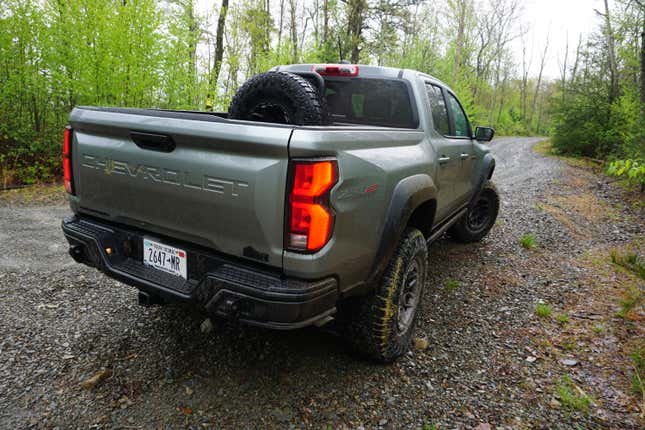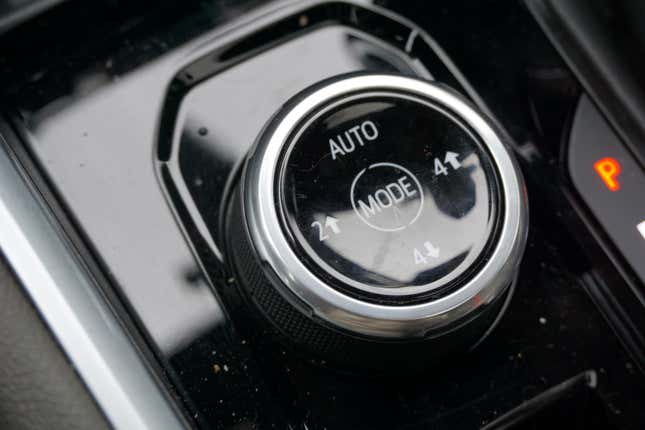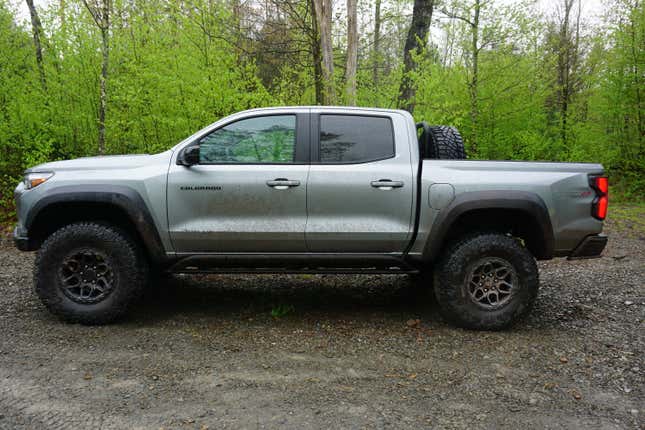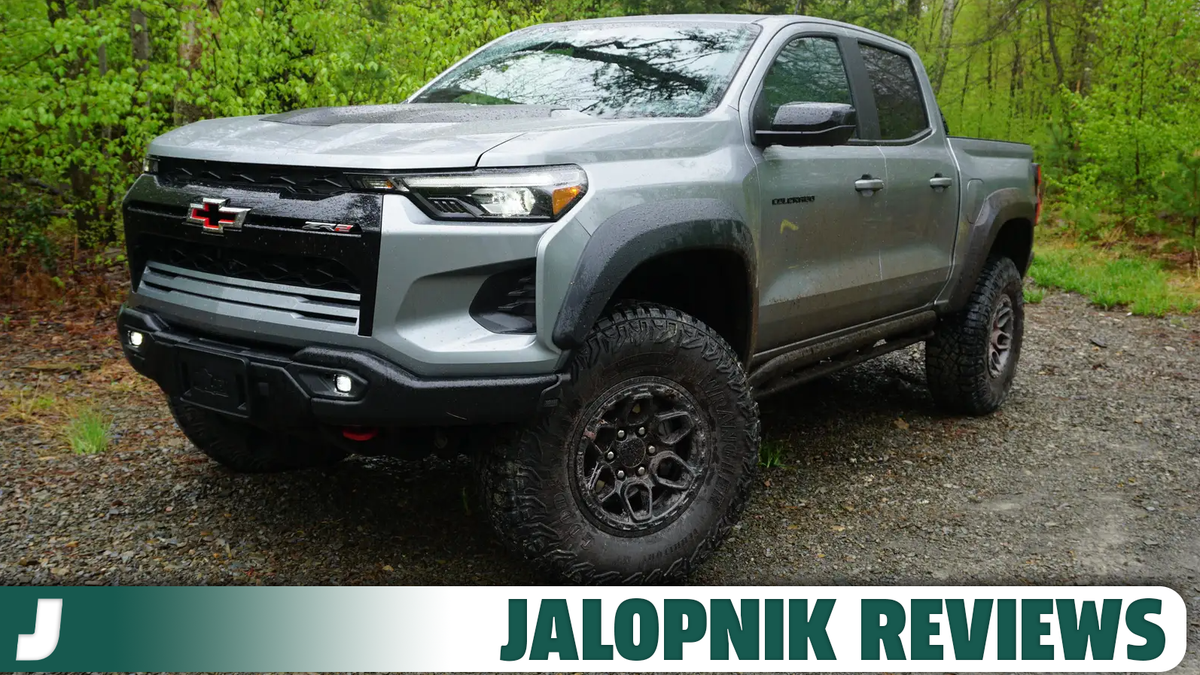Off-roading can seem like a very daunting task for someone who doesn’t really know what they’re doing. All sorts of things can go wrong. You can get lost, get stuck or even damage your car with no easy way to get it back to civilization. The Chevy Colorado ZR2 Bison is here to quell the fears of those who dislike taking the less-traveled road by making it an effortless experience.
Chevy is able to do this by combining new-school off-roading technology with some of the old-school off-roader elements that have been around since man decided to take a car down a dirt path. By doing this, the ZR2 Bison creates such a complete off-roading package that even the most novice dirt traveler will feel at ease behind the leather-wrapped steering wheel.
Full Disclosure: Chevy lent me a Colorado ZR2 Bison with the request that I get it very dirty over a long weekend in the Poconos. The company also gave me a full tank of gas. How nice.

The first thing you notice about the ZR2 Bison when you walk up to it is its absolutely massive wheels and tires. Chevy outfits every Bison with five — yes five, including the full-size spare in the tailgate — 17-inch American Expedition Vehicle beadlock-capable wheels wrapped in 35-inch off-road tires. That alone makes the Colorado ZR2 Bison a formidable off-roading monster. Also part of the ZR2 Bison package are Multimatic front and rear “Jouce Control” dampers, steel skid plates, rock rails, a best-in-class 38.2-degree approach angle, a 26-degree departure angle and a 26.9-degree breakover angle Oh, and lest we forget the Colorado ZR2 Bison also comes with a 12.2-inch best-in-class ground clearance as well as power-locking front and rear differentials, and you’re able to go up and over some really serious obstacles. There’s really nothing in the world that can stop the ZR2 Bison.

Powering this little (comparatively) machine is Chevy’s turbocharged 2.4-liter inline-4 engine that pumps out 310 horsepower and a very beefy 430 pound-feet of torque, and it’s mated up to an eight-speed automatic transmission. This engine is one of my favorite parts of the Colorado, mostly because of the loudness coming from the turbo whistle in the engine bay. It’s so charming! All that being said, while I do really like the motor, it gets pitiful gas mileage in this application. Chevy says it should average 16 mpg across the board in the city, highway and combined cycles, but I wasn’t even able to crack 15 mpg over my 523 miles of mixed driving. It’s a small price to pay.

The motor provides plenty of grunt for going up a rather steep hill, but it can be modulated gingerly enough to make it over some very serious rocks without ruining the truck’s underside. It’s also a fun little engine when you’re blasting down a more wide-open dirt trail or hit the sand, with plenty of power all the way up to its 5,800-rpm redline.
Something else that seriously aids the Colorado ZR2 Bison’s off-roading efforts are its relatively small dimensions. Make no mistake, the Bison is not a small truck. It’s 214 inches long, 80.2 inches wide (without mirrors) and 81.8 inches tall. Those are all very big numbers, but they pale in comparison to half-ton trucks like the Ram 1500 TRX, which is nearly 233 inches long and 88 inches wide. Not only does the Colorado’s size make off-roading easier since you aren’t terribly worried about scratching the truck going down a narrow path, it makes life easier in general — you can juuust about fit in parking spaces with this thing, even. Granted, you do lose some room inside, and the bed is only a bit over 5 feet long, but the four-door crew cab setup still has plenty of space for passengers and their shit.
It isn’t just mechanical bits that aid in the ZR2 Bison’s off-road prowess, but also a slew of tech features that make it all the easier. A great example of this are the various drive modes you can choose from, including off-road-specific modes like Off-Road, Terrain and Baja. Each of these modes changes up the calibration and tuning of the Bison’s engine, transmission and four-wheel-drive system for optimal off-roadage. To help even further, you’ve also got a very user-friendly four-wheel-drive selector system consisting of a couple of buttons that switch between Two High, Four High and Four Low. If you don’t know what you’re doing, you can always leave it in Auto and let the car figure it out for you.

All of this off-roading goodness comes as standard in the $11,700 Bison package, which you add to the price of a $46,800 ZR2. All in all, the truck I tested came in at $64,730 (including destination). $500 of that money goes to the optional — and super cool — Underbody Camera system that points small cameras at the front and rear axles. It may sound like a gimmick, but it did come in handy a few times when traversing over particularly large rocks. It’s also just a neat thing to show your friends! A plethora of other surround-view cameras are part of the Technology Package that lets you make sure you’re never putting your ZR2 Bison in harm’s way.

I spent hours ripping and tearing through the rainy backwoods of northeast Pennsylvania, and not once did I ever feel the Colorado ZR2 Bison was outmatched. Before you say anything, yes this was real off-roading, and no, your Camry could not also go up and down these trails unless you wanted to completely destroy it or get stuck.
The ZR2 Bison is not a cheap vehicle, but when you look at it compared to other off-road-oriented vehicles like the Ford Raptor lineup and Toyota’s TRD offerings, it’s really not too bad. You’re getting some world-beating off-road ability for less than the price of an entry-level luxury crossover.It isn’t reinventing the wheel when it comes to off-roading, but with its really compelling mix of new-school technology and old-school engineering know-how, the Colorado ZR2 Bison is a seriously impressive and fun package that even the biggest idiot (me) can drive off-road with confidence.






